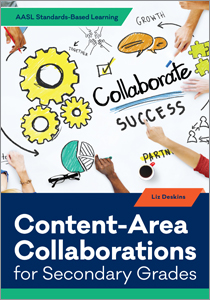Primary tabs
You don't need to be an ALA Member to purchase from the ALA Store, but you'll be asked to create an online account/profile during checkout to proceed. This Web Account is for both Members and non-Members. Note that your ALA Member discount will be applied at the final step of the checkout process.
If you are Tax-Exempt, please verify that your account is currently set up as exempt before placing your order, as our new fulfillment center will need current documentation. Learn how to verify here.
- Description
- Table of Contents
- About the author
- Reviews
For district bulk purchases, State Affiliate events, LIS students, and other special purchasing arrangements, please contact us at editionsmarketing@ala.org.
"Greeting someone with 'I’ve got a great idea for a unit we can do; it will only take 4 weeks!' can be off-putting. Instead begin by building a relationship first."
Read an interview with the author now!
Using the AASL Standards Framework for Learners, this book demonstrates ways to use the Shared Foundations and Domains in your instructional design while collaboratively planning personalized learning experiences with content-area educators. Incorporating contributions from secondary school librarians across the country, this resource contains 20 units rooted in the AASL Standards and tailored to foster collaboration with content areas through alignments with other sets of national standards. This ready-to-go resource, enhanced with discussion questions, rubrics, worksheets, and assessment activities, provides
- three or four learning units in chapters for each Shared Foundation, each unit containing four lessons moving learners through the Domains of Think, Create, Share, and Grow;
- connections between the AASL Standards and other sets of national and content-area standards, highlighting opportunities to approach content area educators with collaboration ideas;
- tips and a template for getting started developing your own collaborative opportunities; and
- numerous additional resources to aid in personalization.
This tool will support school librarians and other educators working together as they strive to deliver and design creative, personalized, and authentic learning experiences using the AASL Standards.
Acknowledgments
Introduction: Maximizing Your Content-Area Collaborations
Chapter 1: Inquire
- A Murder Mystery
- Exploring Career Pathways
- United Nations Tribunal
- Taking Action for Human Rights
Chapter 2: Include
- Making Global Connections
- Awakening Social Justice
- A Culture Convention
- Diversity, Acceptance, and Pride
Chapter 3: Collaborate
- Celebrating Language and Culture with Folktales
- Service Learning across Distance
- Survival of the Species
Chapter 4: Curate
- Adopt a Genre
- Enriching Family Stories with Historical Context
- Building Pathfinders
Chapter 5: Explore
- Igniting Passionate Social Activists
- Hand-Drawn Infographics
- Deep Dive into the Blues
Chapter 6: Engage
- Citation Scavenger Hunt
- Is Seeing Really Believing?
- Managing Your Electronic Reputation
Conclusion: Personalizing Your Content-Area Collaborations
Appendix: Additional Resources
About the Contributors
Index
Liz Deskins
Liz Deskins was a school librarian for thirty years, teaching at the elementary, high school, and college levels. Now retired, she is an adjunct professor for Kent State University. A past president of Buckeye Children and Teens Book Awards as well as past president of OELMA (Ohio Educational Library Media Association), Liz has also served on committees and task forces for the American Association of School Librarians and the Association for Library Service to Children. A requested presenter at conferences, Liz speaks on many topics, thanks to her lifelong passion for learning new things and sharing them with others. Her publications include Linking Picture Book Biographies to National Content Standards: 200+ Lives to Explore (Libraries Unlimited 2015); LGBTQAI+ Books for Children and Teens: Providing a Window for All, written in collaboration with Christina Dorr; and Content-Area Collaborations for Secondary Grades.
"The well‐organized lessons give librarians specific ideas with which they can approach classroom teachers. An appendix of additional resources supplements the featured resources throughout the book. Librarians will find this accessible and useful collection of lessons beneficial in building collaboration. The book is an invitation for librarians and classroom teachers to find common ground built on shared standards and a foundation that strengthens their ability to work together on dynamic lessons that will resonate with students."
— School Library Journal



